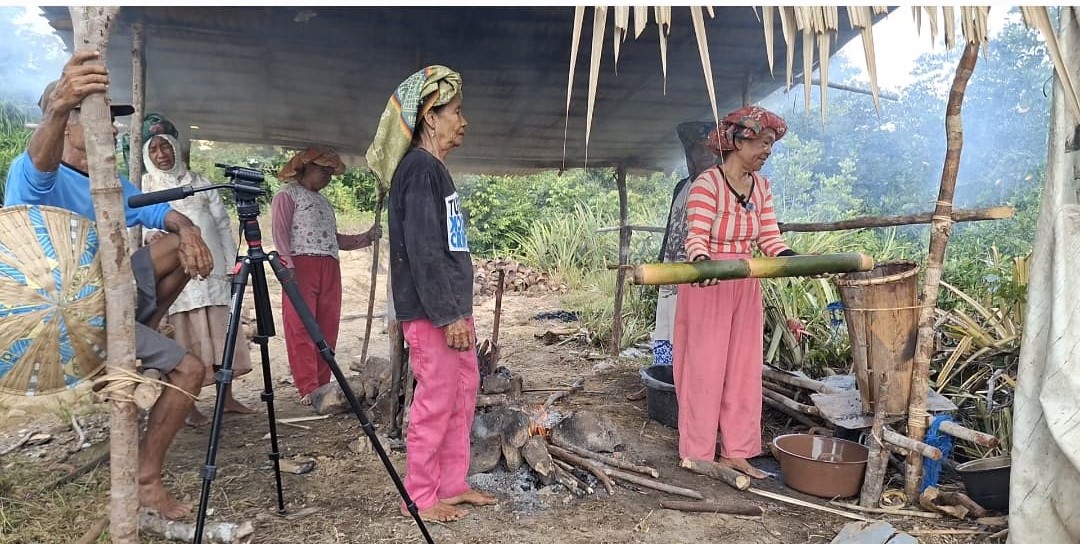Wartakaili.com – On the edge of the Lembanato mangrove forest, the cries of seagulls blend with the chirps of Kureu and Kokolo’o—two endemic birds of the Togean Islands. Gentle waves lick the roots of the mangroves, towering like giant fingers from the muddy sea.
From afar, thin white smoke rises from a clay stove, marking the continuation of an ancient tradition that now teeters on the brink of extinction: making salt from mangrove roots, or Bure nu Bakat, as the Bobongko people call it.
There sits Naning Bakir, a 65-year-old woman, in front of her clay stove, her hands dusted with ash. Every morning, she carries firewood and lights a small, patient fire. The smoke carries a damp, salty aroma that clings to her hair and skin.
“If people only hear stories, they’ll forget,” she says softly, stirring a dark brown liquid. “But once you smell the mangrove smoke, the saltiness stays with you forever.”
Guarding Heritage Against the Tide
Life in Lembanato Village moves slowly, steadily. Dawn comes with the crow of roosters and the call to prayer from a small seaside surau. Farmers head to their fields, fishermen prepare their nets, while children run across wooden piers, chasing the morning light with pure laughter.
Amid this rhythm, Naning walks her own path—venturing into the mangrove forest with a small machete, searching for roots ready to be transformed into salt.
She never takes too much.
“If we get greedy and cut all the roots, the sea will be angry. The fish will leave, the shore will erode, and we’ll suffer,”
she recalls her parents’ warning. That simple wisdom has guided the Bobongko people’s ecological knowledge for generations.
Naning began learning to make salt at sixteen, helping her mother in the kitchen—watching how mangrove roots, when burned, release a thick, sea-scented liquid.
“After school, my hands would already smell of mud and smoke,”
she smiles. From her mother, she also learned that hard work is more than duty—it’s a form of love for nature and life.
“Mother always said, this salt isn’t just for the kitchen. It’s for living. Don’t let it disappear.”
Taboos and Prayers in the Smoke
The tradition of making Bure Nu Bakat isn’t just technical—it’s filled with taboos and rituals. One rule forbids salt-making during the planting of rice or corn.
“If we break it, the crops might fail,” Naning explains.
These beliefs remind the community to respect the balance between human work and nature’s rhythm.
Naning often works with quiet company. Sometimes, the girls of the village sit near her stove, their eyes wide with curiosity. She lets them smell the smoke, hear the crackle of burning wood, and touch the first grains of salt.
“Stories alone can fade,” she says gently. “But if you smell the smoke, the salt stays in your heart. Knowledge must be felt, not memorized.”
Still, keeping a tradition alive in modern times is no easy task. Cheap factory salt has replaced Bure Nu Bakat in most homes, and few young people take interest. Yet Naning remains hopeful.
“Even if I only make a little, just for my family, it’s enough. If one child wants to learn, this tradition will live again. Bure Nu Bakat must not become just a story—it must stay a way of life.”
Salt That Holds Memory
Each grain of salt Naning produces is more than seasoning—it is a crystallization of knowledge, history, and love for nature. Embedded within every batch are prayers and respect for the sea and mangrove forests. Amid environmental degradation and coastal loss, this local wisdom offers a vital lesson.
“When I see the white salt, it feels like I’m seeing my ancestors,”
Naning murmurs, gazing at her salt drying on woven bamboo trays.
“There’s prayer in it, there’s labor, there’s love for nature. That’s why this salt doesn’t just taste salty—it tastes alive.”
A Process Full of Meaning
According to the book Pengetahuan Tradisional dan Tradisi Pengobatan Mombolian di Kepulauan Togean Kabupaten Tojo Una-Una—a project supported by Indonesia’s Ministry of Culture and LPDP—the Bobongko people still make salt for household use.
The process begins with burning carefully selected mangrove roots, specifically the aerial roots of two species—Wakatan Bambar and Wakatan Lolap (Rhizophora sp.). These roots absorb seawater and minerals from the mud, giving the salt its distinctive briny flavor.
The ashes are then filtered, and the resulting liquid is collected in small cube-shaped sago bark molds. This liquid is left to dry under the sun for three to four days, depending on the weather, until it solidifies into cubes of salt—the product of hands, sunlight, and time.
If a clay pot is used instead of a mold, the salt takes its shape. Simple as it looks, each block of Bure Nu Bakat embodies the Bobongko people’s connection to the sea, the earth, and their ancestors.
Salt for the Family Only
Interestingly, Bure Nu Bakat is neither sold nor served to guests. It is reserved exclusively for family meals. Factory salt is used for visitors, while mangrove salt is kept for intimate, everyday cooking—a quiet symbol of identity and belonging.
Its use is also unique: a piece of salt is dipped directly into a pot of soup or stew, then hung back in a rattan holder in the kitchen. One cube can last a year or more, making production rare and sacred.
In the past, villagers would make salt together—a communal ritual after the rice harvest. Families gathered at Teluk Kilat, bringing firewood and mangrove roots, preparing salt for the next planting season. But as shifting cultivation gave way to monoculture plantations, the tradition slowly faded. Today, only a few people like Naning Bakir still keep it alive.
A Fading Trace
The Bobongko people now number around 4,000, scattered across seven villages in the Togean Islands—Lembanato, Matobiai, Baulu, Titiri’i Popolian, Tumbulawa, Patoyan, and Lindo. The mangrove forests around Teluk Kilat still stand tall, but the sounds of daily life have quieted. Many young people leave for work in tourism or mining.
For Naning, it’s not just a loss of labor—it’s a loss of story.
“If the children forget this smoke,” she says, pointing to her rising fire, “they’ll forget how to respect the sea.”
The Salt That Binds Memory
As evening falls, the sun dips behind the mangrove canopy. Naning arranges her salt on bamboo trays. The grains shimmer under the orange light—tiny crystals of time resting in her weathered hands. She looks at them quietly, as if seeing both the past and the future at once.
“Bure Nu Bakat is not just salt,” she whispers. “It’s how we remember who we are. As long as someone keeps making it, the sea and the ancestors will stay close to us.”
And in a world that forgets too quickly, this salt from mangrove roots still holds something constant:
the taste of life itself—born from patience, devotion, and love for nature.
🟢 Editor’s Note: This article is adapted from the book Pengetahuan Tradisional dan Tradisi Pengobatan Mombolian di Kepulauan Togean Kabupaten Tojo Una-Una, supported by the Indonesiana Fund, the Ministry of Culture, and the Indonesia Endowment Fund for Education (LPDP).







